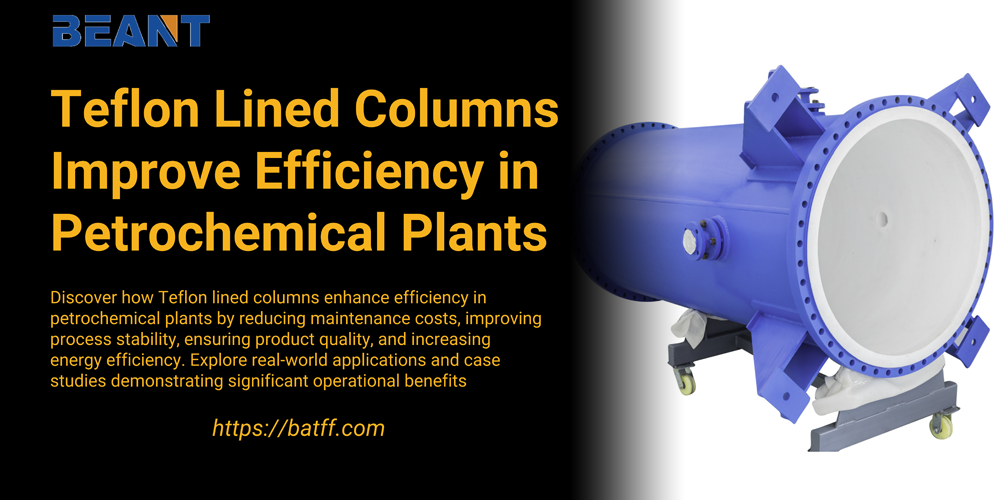
Efficiency in petrochemical plants is crucial due to the high costs associated with production, maintenance, and downtime. Increasing efficiency directly impacts profitability, sustainability, and competitiveness in the industry. Teflon lined columns have emerged as a significant advancement in this context. Known for their exceptional chemical resistance and thermal stability, these columns offer numerous benefits that can greatly enhance the efficiency of petrochemical processes. This article delves into the specific ways Teflon lined columns improve efficiency in petrochemical plants, supported by real-world applications and case studies.
Teflon, a brand name for polytetrafluoroethylene (PTFE), is widely recognized for its unique properties that make it ideal for use in lining columns in petrochemical plants. Understanding these properties is essential to appreciating their role in improving efficiency.
1.Chemical Resistance: Teflon is highly resistant to a wide range of chemicals, including acids, bases, and solvents. This resistance prevents the interior surfaces of the columns from corroding or reacting with the process chemicals, thus maintaining the integrity of the columns and the purity of the products.
2.Thermal Stability: Teflon can withstand high temperatures without degrading. This property ensures that Teflon lined columns can operate efficiently under the extreme thermal conditions often present in petrochemical processes.
3.Non-stick Properties: Teflon’s non-stick surface prevents materials from adhering to the column walls. This reduces the buildup of residues that can lead to blockages and inefficiencies in the process.
4.Durability and Longevity: The robustness of Teflon ensures a long service life for lined columns, minimizing the need for frequent replacements and associated downtimes.
Teflon lined columns contribute to enhanced efficiency in petrochemical plants in several significant ways.
Corrosion is a major issue in petrochemical plants due to the harsh chemical environments. Traditional materials, such as stainless steel, are prone to corrosion, leading to frequent maintenance and replacements. Teflon’s exceptional chemical resistance virtually eliminates corrosion, resulting in:
Lower maintenance costs: Reduced need for repairs and replacements.
Increased uptime: Less frequent maintenance means more operational hours.
Extended equipment life: Teflon lined columns last longer, providing a better return on investment.
Process stability is crucial for consistent and efficient operation. Teflon’s thermal stability ensures that lined columns can handle temperature fluctuations without compromising their performance. This leads to:
Fewer process interruptions: Stable columns reduce the likelihood of breakdowns.
Consistent operation: Maintains steady processing conditions, which is vital for product quality.
Contamination is a significant concern in petrochemical processing, as it can affect product quality and safety. Teflon’s non-reactive nature prevents contamination, ensuring:
Higher product purity: Non-reactive surfaces do not introduce impurities.
Better product consistency: Consistent column performance leads to uniform product quality.
Energy costs are a major component of operating expenses in petrochemical plants. Teflon’s thermal properties contribute to better energy efficiency by:
Reducing energy loss: Teflon lined columns maintain temperature more effectively.
Lowering energy consumption: Improved thermal efficiency reduces the amount of energy needed to maintain process conditions.
Several petrochemical plants have successfully implemented Teflon lined columns, realizing substantial efficiency improvements. Here are some real-world examples:
A large chemical plant in Texas was facing frequent maintenance issues due to the corrosive nature of the chemicals processed in their columns. The plant decided to retrofit their columns with Teflon linings. The results were remarkable:
Maintenance costs were reduced by 40%.
The plant experienced a 30% increase in operational uptime.
Product purity improved, leading to fewer quality control issues.
A petrochemical plant in India dealing with high operational costs due to energy inefficiency and process instability implemented Teflon lined columns. The implementation led to:
A 25% reduction in energy consumption due to improved thermal efficiency.
Enhanced process stability, reducing downtime by 20%.
Overall operational costs decreased by 15%.
A refinery in the Middle East, processing highly corrosive substances, adopted Teflon lined columns to mitigate corrosion issues. The benefits included:
Significantly extended column lifespan, reducing replacement frequency.
Improved safety due to the reduced risk of leaks and contamination.
Enhanced efficiency in the refining process, leading to higher throughput.
These examples underscore the practical benefits of Teflon lined columns in enhancing efficiency across various aspects of petrochemical plant operations.
Implementing Teflon lined columns involves an initial investment, but the long-term benefits often outweigh the costs. A detailed cost-benefit analysis typically reveals:
Initial Costs: While the upfront cost of Teflon lined columns is higher than traditional materials, this is offset by the savings in maintenance, energy, and downtime.
Long-term Savings: Reduced maintenance and replacement costs, lower energy consumption, and increased operational uptime contribute to substantial long-term savings.
Return on Investment (ROI): Plants that invest in Teflon lined columns often see a positive ROI within a few years due to the cumulative cost savings and efficiency gains.
To maximize the benefits of Teflon lined columns, careful consideration must be given to the implementation process:
Compatibility: Ensure that the existing systems and processes are compatible with Teflon lined columns. This may involve some modifications to accommodate the new material.
Installation: Proper installation is crucial for achieving the desired efficiency improvements. Working with experienced professionals can help ensure that the installation is done correctly.
Maintenance: Although Teflon lined columns require less maintenance, regular inspections are necessary to monitor their condition and performance. Adopting best practices in maintenance can further extend the lifespan of the columns.
Teflon lined columns represent a significant advancement in the quest for greater efficiency in petrochemical plants. Their exceptional chemical resistance, thermal stability, non-stick properties, and durability contribute to reduced maintenance costs, enhanced process stability, improved product quality, and energy efficiency. Real-world applications and case studies demonstrate the tangible benefits that petrochemical plants can achieve by adopting Teflon lined columns. Despite the higher initial investment, the long-term savings and efficiency gains make Teflon lined columns a smart choice for improving operational performance. As the petrochemical industry continues to evolve, embracing innovative solutions like Teflon lined columns will be key to staying competitive and achieving sustainable growth.
Feel free to leave your message on our board. If you're looking to inquire about prices or place an order, this is the right place! Let us know the details of your needs, and our team will get back to you with a personalized quote as quickly as possible. We're here to ensure your experience is seamless and satisfactory. Share your requirements or ask any questions you might have - we're eager to assist and look forward to doing business with you!
Name:Tim
Phone:+86-15716151880
Email:[email protected]
Company:BEANT
Address:No. 28, Luoshen Road, Luoshe Town, Huishan District, Wuxi City, Jiangsu Province
